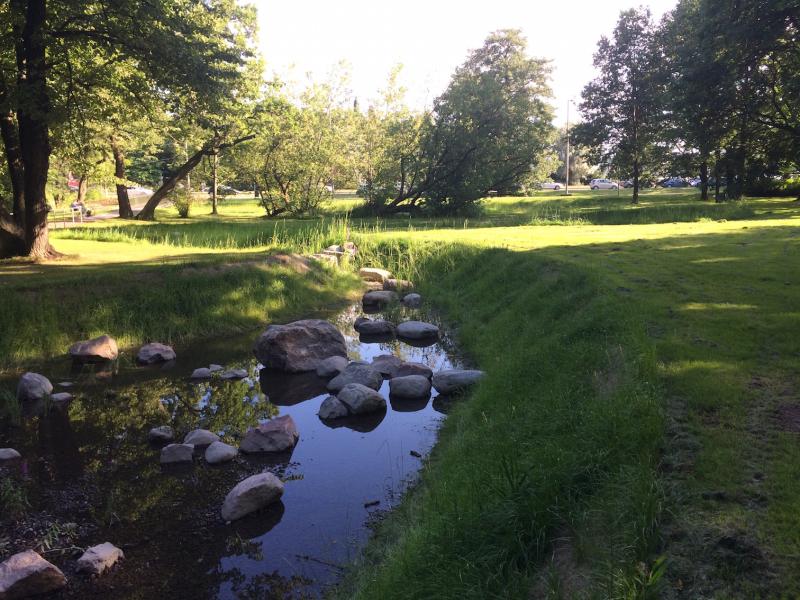Adapting to climate change
Adapting to climate change, or climate change adaptation, refers to the means of preparing for extreme weather phenomena and reducing the detrimental effects of climate change.
We will all have to adapt to the consequences of our planet’s climate crisis. The health, property and way of life of Helsinki’s inhabitants must be protected. The goal is to prepare Helsinki well for extreme weather phenomena and their indirect effects.
Helsinki City Strategy 2021–2025
Helsinki will take the actions required for adaptation. Preparation must be integrated into city planning, new construction and reconstruction projects. Helsinki has assessed the weather and climate risks concerning the city. The City’s key climate risks are stormwater floods caused by heavy rain, a sudden raise in sea level caused by storms, slipperiness, extreme and abnormal winter conditions, heatwaves, drought and the eutrophication of the Baltic Sea.

Climate change adaptation policies – a key climate risk management programme
Helsinki’s climate change adaptation policies 2019–2025 is a programme through which the City of Helsinki aims to adapt to climate change and prepare for extreme weather phenomena. The vision of the policies is ‘Climate-proof Helsinki in 2050’. The adaptation measures are included in the City’s planning and guidance, for example, in land use planning, preparation and preparedness planning, stormwater management, the development of green areas and structures, and nature conservation and management.
Progress of Helsinki’s climate change adaptation policies 2019–2025 in 2021
A City-level expert group for adaptation, appointed by the Head of the City Executive Office, started operating in autumn 2021. The group is tasked with prioritising and concretising the actions presented in the adaptation policies. The group’s work is underway, with the first adaptation priorities being natural stormwater management, climate-proof construction and renovation projects, reinforcement of green structures, and climate risk management as a part of the City’s management system.
Stormwater management is key in climate change adaptation. The quantitative and qualitative stormwater management are directed through the stormwater programme. To enhance the stormwater quality control, the HuLaKaS project was initiated, through which Helsinki aims to define qualitative risk areas for stormwater. The quality of the stormwater flowing from the Mechelininkatu street and the functionality of the filtering solution in Taivallahti will also be monitored separately. The functionality and filtering performance of the stormwater filtering structure in Kuninkaantammi will also be monitored for 1.5 years, approximately.
The green factor method is used to create green, comfortable and climate-proof plots in the increasingly dense urban structure, which also promotes the climate change adaptation of urban areas. A plot-specific green factor will be used for all land use plans if there are no special reasons for deviating from it. A survey was carried out (by WSP) on the use and impact of the green factor, also including suggestions on how to develop the tool. The development work on the regional green structure tool to be used in city planning is underway.
Helsinki’s Sustainable Energy and Climate Action Plan (SECAP) was prepared. SECAP compiled the City’s climate programmes and plans and the assessments regarding climate risks and vulnerability.
Nature-based solutions support adaptation
Part of preparing for [climate change] will include planting more trees and adding more green spaces to the city. Drought-resistant greenery will be added to Helsinki parks and green walls and roofs will assist with drainage. Effective green solutions can help manage storm water, minimise flood risks and limit the heat island effect of hotter temperatures in urban areas.
Helsinki City Strategy 2021–2025
Helsinki has adopted natural solutions for stormwater management and increasing greenery in the urban structure. Natural solutions promote adaptation to climate change while also producing several other benefits, such as health benefits, recreation opportunities and greener residential environments.
The City of Helsinki, in collaboration with Ramboll, has compiled information and instructions on making the existing yards of blocks of flats greener in the form of an information package. The information package showcases the history of residential yards, illustrates nature-based solutions and their impact and benefits, and provides examples of yard renovations. The package also includes separate information cards for designers and residents on using the yards and for housing managers and housing companies for maintenance.
The B.Green project creates new green infrastructure solutions and the associated digital tools to support city planning. The project will create a participatory city planning model that will help green infrastructure solutions to be applied widely.
In autumn 2021, a communication campaign on adapting to climate change, directed towards residents, with the theme ‘green solutions – superheroes of climate change.’ The campaign was implemented through Facebook, Instagram, Twitter posts and theAd Shel digital screens on the streets of the city centre.
Eyes on the future
Helsinki is preparing for extreme weather phenomena and the continuously changing climate and its consequences. Helsinki is strengthening its climate resilience through impactful adaptation measures. Climate change affects groups of people, businesses and areas in various ways. When assessing the impact of climate change, Helsinki will emphasise fairness in its preparation and decision-making and aiming measures with consideration to social vulnerability.
